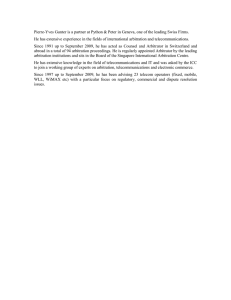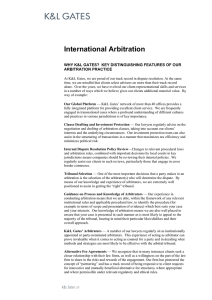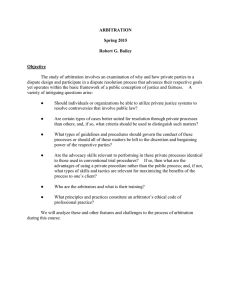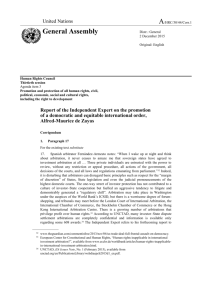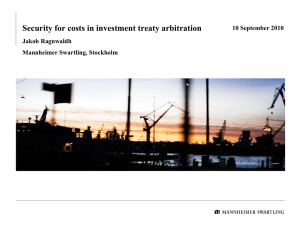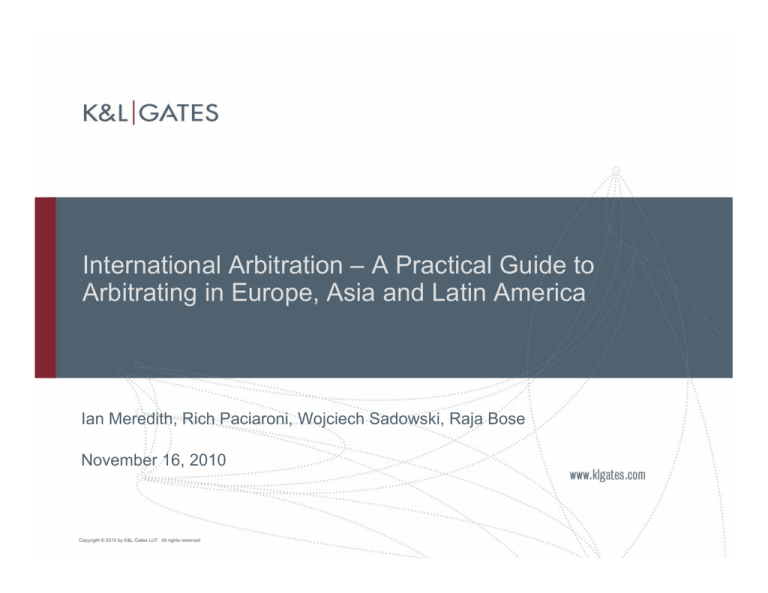
International Arbitration – A Practical Guide to
Arbitrating in Europe, Asia and Latin America
Ian Meredith, Rich Paciaroni, Wojciech Sadowski, Raja Bose
November 16, 2010
Copyright © 2010 by K&L Gates LLP. All rights reserved.
Presenters
Ian Meredith
Partner
London
Raja Bose
Partner
Singapore
Wojciech Sadowski
Of Counsel
Warsaw
Rich Paciaroni
Partner
Pittsburgh
+44.20.7360.8171
ian.meredith@klgates.
com
656.507.8125
raja.bose@klgates.com
+48.22.653.4201
wojciech.sadowski@klgate
s.com
412.355.6767
rich.paciaroni@klgates
.com
1
Overview
But I Thought Arbitration Was Supposed to be a
Flexible System?
Tribunal Selection
Interim Measures
Written Advocacy
Document Production
The Role of Witnesses in International Arbitration
The Hearing
Q&A
2
But I Thought Arbitration Was Supposed to be
a Flexible System?
To what extent is there now an established best
practice in International Commercial Arbitration?
The role of the “guidelines”—Do we read too
much into them?
What happens when the “Arbitration Terrorist”
meets the “Town Elder”?
3
Tribunal Selection
Impartiality and Independence
UNCITRAL Rules: Disclosure of
circumstances giving rise to “justifiable doubts”
The IBA Guidelines on Conflicts of Interest in
International Arbitration (May 2004)
Non-Waivable Red List
Waivable Red List
Orange List
Green List
4
Tribunal Selection – Cont’d.
Selection by different arbitral institutions
ICC Rules – proposal by National Committee
LCIA Rules –various factors such as nature
of transaction and dispute; location and
language of parties
SIAC Rules – no ex parte communication
relating to case
5
Tribunal Selection – Cont’d.
Current Issues
Lack of perceived impartiality / cultural
sensitivity
Counsel and arbitrators from same set of
chambers in London
Jivraj v. Hashwani (CA) –
Employer/Employee relationship; no
discrimination?
6
Interim Measures
Importance of interim measures from the legal and
business standpoints
Where to apply:
State courts and/or arbitral tribunals
Pros and cons
Conditions of a successful application
Available remedies
How interim is interim or when do the effects of an
interim measure cease
7
Pleadings
Different jurisdictions, people, approaches
Primacy of substance above form
Emergence of lingua franca of int’l arbitration
writing
Notice of arbitration v. statement of claim
Further pleadings
‘The word is not enough’ or what comes along the
submissions
8
Document Production
The “Conventional” approach under the IBA Rules
(June 2010 version)
“documents relied upon” to be produced alongside
submissions
Requests to Produce – different thoughts on the
application of Article 3(3) test – “… relevant to the
case and material to its outcome”
The sign says “No Fishing” – What does “… a
narrow and specific requested category” mean in
practice?
9
Document Production – Cont’d.
Article 9(2) bases for withholding production including
the question of the law under which the Tribunal
should determine privilege - the “closest connection
test” in practice
The Redfern Schedule
Electronic documents in International Arbitration
Third party production (Article 3(9))
Ancillary proceedings under 28 USC 1781 and its
sister process
Protecting confidentiality (Articles 3(13) and 9(4))
10
Use of Fact Witnesses in International
Commercial Arbitration
Informant vs. Witness
Direct testimony usually in written statements
Witness must appear for cross-examination
Typically no US style depositions
IBA Rules on the Taking of Evidence – Art. 4
11
Use of Expert Witnesses in International
Commercial Arbitration
Skeptical view of party appointed experts
IBA Rules – Art. 5
Tribunal appointed expert may be appointed
Rare occasion now, maybe more in the future
IBA Rules – Art. 6
No US style depositions
“Hot tubbing” experts is trendy
12
The Hearing
The Speakers share their thoughts on what parties can
expect at the evidentiary hearing.
13
Questions?
14

